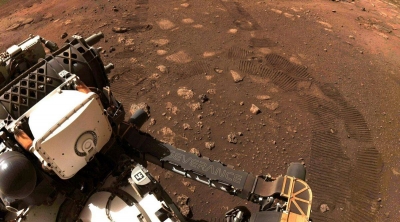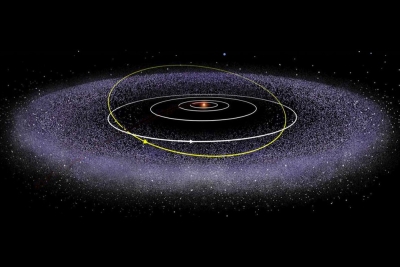
Mars rover’s microphone captures ten seconds of rumbling noise created by dust devil on the Red Planet. It’s the same microphone that provided the first sounds of Martian wind in 2021.
What does a dust devil sound like on Mars? A NASA rover by chance had its microphone on when a whirling tower of red dust passed directly overhead, recording the racket.
It’s about 10 seconds of not only rumbling gusts of up to 40 kph, but the pinging of hundreds of dust particles against the rover Perseverance. Scientists released the first-of-its-kind audio. It sounds strikingly similar to dust devils on Earth, although quieter since Mars’ thin atmosphere makes for more muted sounds and less forceful wind, according to the researchers.
The dust devil came and went over Perseverance quickly last year, thus the short length of the audio, said the University of Toulouse’s Naomi Murdoch, lead author of the study appearing in Nature Communications.
At the same time, the navigation camera on the parked rover captured images, while its weather-monitoring instrument collected data.
“It was fully caught red-handed by Persy,” said co-author German Martinez of the Lunar and Planetary Institute in Houston.
Photographed for decades at Mars but never heard until now, dust devils are common at the red planet.
This one was in the average range: at least 400 feet (118 metres) tall and 80 feet (25 metres) across, travelling at 16 feet (5 metres) per second.
The microphone picked up 308 dust pings as the dust devil whipped by, said Murdoch, who helped build it.
Given that the rover’s SuperCam microphone is turned on for less than three minutes every few days, Murdoch said it was “definitely luck” that the dust devil appeared when it did on Sept. 27, 2021. She estimates there was just a 1-in-200 chance of capturing dust-devil audio. Of the 84 minutes collected in its first year, there’s “only one dust devil recording,” she wrote in an email from France.
WHAT IS A DUST DEVIL?
- Common across Mars, dust devils are short-lived whirlwinds loaded with dust that form when there is a major difference between ground and air temperatures.
- They are a common feature in the Jezero crater, where the Perseverance rover has been operational since February 2021 – but it had never before managed to record audio of one of them.
- By chance on September 27, 2021, a dust devil 118 metres high and 25 metres wide passed directly over the rover.
- This time, the microphone on the rover’s SuperCam managed to catch the muffled, whirring sounds.
Sounds…so far
- The same microphone on Perseverance’s mast provided the first sounds from Mars namely the Martian wind soon after the rover landed in February 2021.
- It followed up with audio of the rover driving around and its companion helicopter, little Ingenuity, flying nearby, as well as the crackle of the rover’s rock-zapping lasers, the main reason for the microphone.
ROCK SAMPLES
On the prowl for rocks that might contain signs of ancient microbial life, Perseverance has collected 18 samples so far at Jezero Crater, once the scene of a river delta. NASA plans to return these samples to Earth a decade from now. Its helicopter Ingenuity has logged 36 flights, the longest lasting almost three minutes.
CAN ACOUSTIC DATA SOLVE THE MARTIAN MYSTERY?
- These recordings allow scientists to study the Martian wind, atmospheric turbulence and now dust movement as never before.
- The impact of the dust-made “tac tac tac sounds will let researchers count the number of particles to study the whirlwind’s structure and behaviour.
- It could also help solve a mystery that has puzzled scientists. On some parts of Mars, whirlwinds pass by sucking up dust, cleaning the solar panels of rovers along the way.
- Understanding why this happens could help scientists build a model to predict where the whirlwinds might strike next.
- It could even shed light on the great dust storms that sweep across the planet, famously depicted in the 2015 science-fiction film “The Martian”.
Picture Credit : Google





